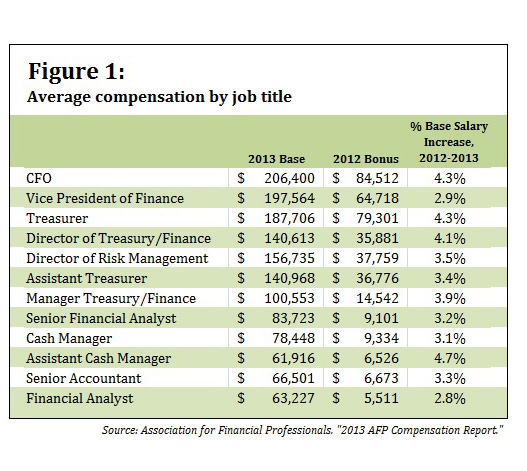Earlier this week, the Association for Financial Professionals released its "2013 AFP Compensation Report," which tabulates the results of a survey of more than 2,700 finance professionals throughout the United States. Respondents across the board reported increases in their base salaries from January 1, 2012, to January 1, 2013. Those at the executive level earned the largest increase—3.8 percent, on average, vs. 3.5 percent for managers and 3.1 percent for finance staff. CFOs and treasurers each saw an average increase of 4.3 percent in their base salary.
|
In addition to their base salaries, 73 percent of this year's survey respondents reported that their company provides incentive-based compensation bonuses for finance executives, managers, and/or staff. Among the companies that offer incentive pay, 98 percent give cash bonuses and 34 percent give stock-option bonuses.
|The average bonus for a finance executive in 2012 was 2.5 percent higher than in 2011 and 21 percent higher than in 2010, but bonuses for lower-level finance staff didn't fare as well. Managers saw their incentive compensation drop by 6 percent from 2011 to 2012, and bonuses for finance staff fell nearly 9 percent over the same period. Moreover, executives have seen their bonuses increase as a percentage of their base salary, as their base salaries have risen substantially, while results have been mixed for finance professionals at lower levels.
|
The AFP survey revealed that a wide range of factors impact the type and size of performance bonuses in the finance function. Fifty-nine percent of companies base finance professionals' bonuses on achievement of operating income or EBITDA goals. Other key financial metrics that affect bonuses include hitting profit targets (50 percent), sales or revenue targets (32 percent), cost control or cost reduction targets (32 percent), and cash flow targets (26 percent). Fewer organizations hang bonuses for the finance team on softer performance measures, such as completion of specific projects (52 percent) or customer satisfaction (18 percent).
|
When asked to identify influences on career advancement in their organization's finance department, 29 percent of respondents said that an MBA or other advanced degree helps finance professionals get ahead. The survey found that a finance pro with an advanced degree such as an MBA earns an average of $10,000 more than a finance pro with only a bachelor's degree. In staff-level positions, the financial bump for a graduate degree is 19.2 percent.
|Geographic region is another influencer of compensation. Across all job titles, respondents in the West make the most, followed by those in the Northeast, in the South, and in the Midwest. Among treasurers, however, jobs in the Northeast pay more than 10 percent better, on average, than jobs in any other region.
|
Not surprisingly, the survey found that the largest determinant of salary differences among individuals with the same job title is the size of the organization. CFOs in companies with annual revenues over $1 billion make more than twice as much as those in companies with less than $100 million in revenue, and assistant treasurers in the largest companies make more than treasurers in the smallest companies.
|
Complete your profile to continue reading and get FREE access to Treasury & Risk, part of your ALM digital membership.
Your access to unlimited Treasury & Risk content isn’t changing.
Once you are an ALM digital member, you’ll receive:
- Critical Treasury & Risk information including in-depth analysis of treasury and finance best practices, case studies with corporate innovators, informative newsletters, educational webcasts and videos, and resources from industry leaders.
- Exclusive discounts on ALM and Treasury & Risk events.
- Access to other award-winning ALM websites including PropertyCasualty360.com and Law.com.
*May exclude premium content
Already have an account? Sign In
© 2024 ALM Global, LLC, All Rights Reserved. Request academic re-use from www.copyright.com. All other uses, submit a request to [email protected]. For more information visit Asset & Logo Licensing.







